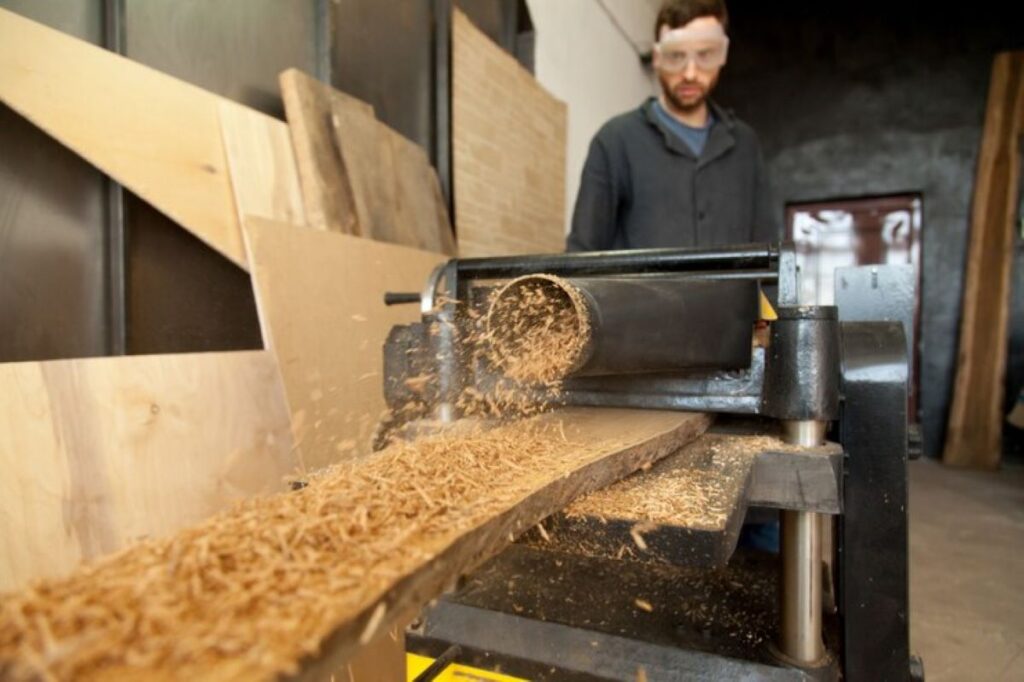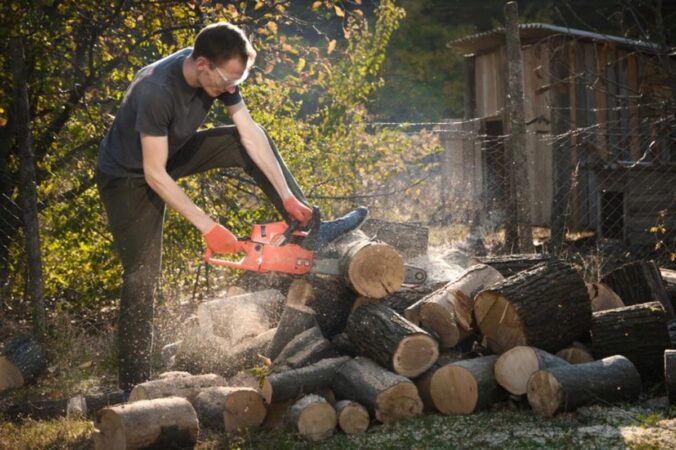If you have recently cut down a tree in your yard, you may be left with an unsightly tree stump. Not only do these stumps detract from the overall appearance of your landscape, but they can also pose safety hazards. Tree stump grinding is a safe and effective way to remove these unwanted stumps from your yard. In this article, we will discuss the basics of tree stump grinding, safety measures to follow, how to choose the right stump grinder, the process of grinding a stump, and post-grinding clean-up and maintenance.
Understanding the Basics of Tree Stump Grinding
Tree stump grinding is a process that involves using a machine to mechanically grind and cut the stump and its roots into small wood chips. This method eliminates the need for digging or manual removal, making it a more efficient and cost-effective solution. By grinding the stump, you can remove it entirely, making way for new landscaping or construction projects.
So, why is tree stump grinding necessary?
What is Tree Stump Grinding?
Tree stump removal is a method used to remove tree stumps and their roots from the ground. It involves the use of a stump grinder, which is a heavy-duty machine specifically designed for this task. The grinder features a rotating cutting wheel with sharp teeth that grind away the stump, turning it into wood chips or mulch.
Why is Tree Stump Grinding Necessary?
There are several reasons why it is necessary to grind tree stumps. First and foremost, stumps can be unsightly and decrease the aesthetic appeal of your property. Additionally, stumps can be dangerous obstacles, especially if they are hidden by grass or foliage. They can cause injury, especially to children or individuals who are not aware of their presence. Furthermore, tree stumps can attract pests such as termites or ants, which can spread to nearby trees or even your home. Removing tree stumps also creates space for new landscaping or construction projects and helps prevent the regrowth of the tree.
But let’s delve deeper into the process of tree stump grinding. When you hire a professional stump grinding service, they will typically start by assessing the size and condition of the stump. This allows them to determine the most suitable equipment and approach for the job. They will also take into consideration the location of the stump, as accessibility can affect the complexity of the task.
Once the assessment is complete, the stump grinding process begins. The stump grinder is positioned near the stump, and the cutting wheel is lowered onto the wood. As the wheel rotates, the sharp teeth make contact with the stump, grinding it down layer by layer. The grinder is maneuvered to ensure that the entire stump and its major roots are ground into small wood chips or mulch.
It’s important to note that stump grinding is a precise and controlled process. The operator carefully guides the grinder to ensure that it only removes the stump and its roots, without causing damage to surrounding structures or landscaping. This level of precision requires skill and experience, which is why it’s recommended to hire a professional stump grinding service.
Once the grinding is complete, the resulting wood chips or mulch can be used for various purposes. Some homeowners choose to spread the wood chips in their garden beds as a natural mulch, which helps retain moisture and suppress weed growth. Others may opt to have the wood chips removed from the site, leaving a clean and clear space for future landscaping or construction projects.
So, the next time you come across an unsightly tree stump on your property, consider the benefits of tree stump grinding. Not only does it eliminate the need for manual removal, but it also improves the safety and aesthetics of your outdoor space. By hiring a professional stump grinding service, you can ensure a thorough and efficient removal process, giving you the freedom to transform your landscape into something truly remarkable.
Safety Measures for Tree Stump Grinding
Before you begin the stump grinding process, it is essential to prioritize safety. By following the appropriate safety measures, you can protect yourself and others from potential accidents or injuries. Here are some safety precautions to consider:
Personal Protective Equipment for Stump Grinding
When operating a stump grinder, it is crucial to wear the appropriate personal protective equipment (PPE). This includes safety goggles or a face shield to protect your eyes from flying debris, ear protection to reduce noise exposure, gloves to protect your hands, and sturdy boots with slip-resistant soles. It is also recommended to wear long pants and a long-sleeved shirt to protect your skin from scratches or cuts.
Furthermore, it is important to ensure that your clothing fits properly and does not pose a risk of getting caught in the stump grinder’s moving parts. Loose clothing or accessories like jewelry should be avoided to prevent entanglement hazards during operation. Remember, safety should always come first when working with heavy machinery.

Pre-Grinding Safety Checks
Prior to operating the stump grinder, make sure to inspect the machine for any damage or defects. Check that all safety features are functioning correctly and that the cutting wheel is sharp and secured tightly. Ensure that there are no obstacles or hazards in the work area, such as rocks or large tree roots, which could pose a risk during grinding. Additionally, it is essential to mark any underground utilities to avoid damaging them during the grinding process.
Moreover, familiarize yourself with the specific controls and operation of the stump grinder before starting. Understanding how to safely maneuver the machine, engage the cutting wheel, and adjust grinding depth will help prevent accidents and ensure a more efficient grinding process. Take the time to read the manufacturer’s instructions and guidelines for operating the equipment properly.
Choosing the Right Stump Grinder
Choosing the right stump grinder for your needs is crucial. There are several factors to consider when selecting a stump grinder:
Factors to Consider When Selecting a Stump Grinder
One of the primary considerations is the size and hardness of the stumps you will be grinding. Smaller stumps can typically be effectively removed with a smaller, handheld stump grinder, while larger stumps may require a larger, self-propelled or tow-behind grinder. It is also important to consider the accessibility of the stump. If the stump is in a tight or confined space, a smaller, more maneuverable grinder may be necessary.
Another factor to keep in mind is the terrain where the stump is located. If the stumps are on uneven or sloped ground, a self-propelled grinder with better traction and stability may be the safer choice. Additionally, the type of wood from which the stumps originate can impact the grinder selection. Hardwood stumps, such as oak or hickory, will require a more powerful grinder compared to softer wood like pine or cedar.
Different Types of Stump Grinders
There are different types of stump grinders available, including handheld grinders, walk-behind grinders, and self-propelled or tow-behind grinders. Each type has its advantages and limitations, so it is essential to choose the one that best suits your specific needs. For smaller stumps or those in hard-to-reach areas, a handheld grinder may be the most practical option. However, for larger stumps or extensive grinding jobs, a self-propelled or tow-behind grinder may offer greater power and efficiency.
Walk-behind stump grinders provide a good balance between power and maneuverability, making them suitable for a wide range of stump sizes and locations. On the other hand, self-propelled or tow-behind grinders are ideal for commercial or heavy-duty applications where efficiency and speed are paramount. Understanding the differences between these types of stump grinders can help you make an informed decision based on your specific requirements and budget.
The Process of Tree Stump Grinding
Tree stump grinding is a crucial step in the process of removing unwanted tree stumps from your property. Not only does it improve the aesthetics of your landscape, but it also helps prevent potential hazards and allows for new plantings or construction projects. Understanding the steps involved in stump grinding can help you tackle this task efficiently and safely.

Preparing the Area for Grinding
Prior to firing up the stump grinder, it is essential to prepare the surrounding area for the grinding process. This involves clearing the vicinity of any rocks, debris, or large tree roots that could impede the grinder’s progress. Additionally, trimming low-hanging branches and vegetation around the stump can facilitate easier access and maneuverability during grinding. To prevent any mishaps, it is advisable to mark the area to avoid damaging underground utilities or nearby structures.
Step-by-Step Guide to Grinding a Stump
1. Adjust the cutting depth of the stump grinder to the appropriate level, typically a few inches below ground to ensure complete removal of the stump and its root system. 2. Position the grinder directly over the center of the stump, aligning the cutting wheel parallel to the ground for optimal results. 3. Start the grinder and gradually lower the cutting wheel into the stump, employing steady back-and-forth or circular motions to grind away the wood. 4. Move the grinder outward towards the edges of the stump, systematically breaking down the entire stump into wood chips. 5. Continue the grinding process until you reach the desired depth, usually between 6 to 12 inches below ground level for thorough removal. 6. Upon completion, lift the cutting wheel and relocate the grinder away from the stump. 7. To finish off, fill the resulting hole with soil or compost to level the ground and encourage new grass or vegetation growth, seamlessly blending the area back into your landscape.
Post-Grinding Clean-up and Maintenance
After grinding a tree stump, it is important to clean up the debris and perform routine maintenance on your stump grinder:
Cleaning Up After Grinding
Remove any wood chips, debris, or remaining pieces of the stump from the work area. Collect the wood chips and use them as mulch in your garden or dispose of them responsibly. Rake the area to remove any small wood particles, and inspect the surrounding landscape for any damage or potential hazards caused during the grinding process.
Maintaining Your Stump Grinder
Regular maintenance of your stump grinder is essential to ensure its optimal performance and longevity. Follow the manufacturer’s guidelines for maintenance and servicing, including regular inspections, lubrication, and blade sharpening or replacement. Store the stump grinder in a dry and secure location, away from harsh weather conditions or potential theft.
By following these guidelines, you can safely and effectively grind tree stumps to improve the appearance and safety of your yard. Tree stump grinding is a task that is best left to professionals if you are unsure or uncomfortable with operating the equipment. Consult with a professional tree service or stump grinding company for expert advice and assistance.
Related: Understanding Stump Grinding Prices: What to Expect

Leave a Reply